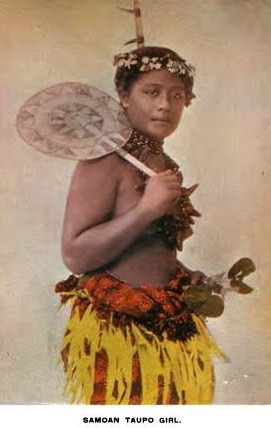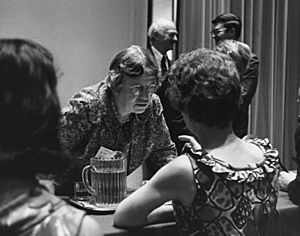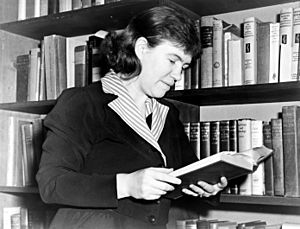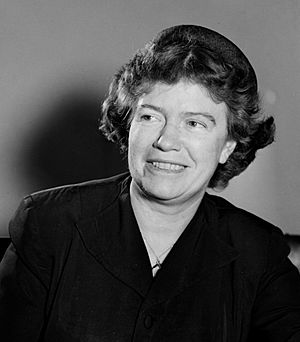Margaret Mead facts for kids
Quick facts for kids
Margaret Mead
|
|
|---|---|

Mead in 1948
|
|
| Born | December 16, 1901 Philadelphia, Pennsylvania, U.S.
|
| Died | November 15, 1978 (aged 76) New York City, U.S.
|
| Resting place | Trinity Episcopal Church Cemetery, Buckingham, Pennsylvania |
| Education | |
| Occupation | Anthropologist |
| Spouse(s) |
Luther Cressman
(m. 1923; div. 1928)Reo Fortune
(m. 1928; div. 1935) |
| Children | Mary Catherine Bateson |
| Relatives | Jeremy Steig (nephew) |
| Awards |
|
Margaret Mead (December 16, 1901 – November 15, 1978) was an American cultural anthropologist who featured frequently as an author and speaker in the mass media during the 1960s and 1970s. She earned her bachelor's degree at Barnard College in New York City and her M.A. and Ph.D. degrees from Columbia University. Mead served as President of the American Association for the Advancement of Science in 1975.
Contents
Early life
Margaret Mead, the first of five children, was born in Philadelphia but raised in nearby Doylestown, Pennsylvania. Her father, Edward Sherwood Mead, was a professor of finance at the Wharton School of the University of Pennsylvania, and her mother, Emily (née Fogg) Mead, was a sociologist who studied Italian immigrants. Her sister Katharine (1906–1907) died at the age of nine months. That was a traumatic event for Mead, who had named the girl, and thoughts of her lost sister permeated her daydreams for many years.
Education
Her family moved frequently and so her early education was directed by her grandmother until, at age 11, she was enrolled by her family at Buckingham Friends School in Lahaska, Pennsylvania.
Mead studied one year, 1919, at DePauw University, then transferred to Barnard College. She earned her bachelor's degree from Barnard in 1923.
Nead began studying with professors Franz Boas and Ruth Benedict at Columbia University, and earned her master's degree in 1924. She set out in 1925 to do fieldwork in Samoa.
In 1926, she joined the American Museum of Natural History, New York City, as assistant curator. She received her Ph.D. from Columbia University in 1929.
Career
During World War II, Mead was executive secretary of the National Research Council's Committee on Food Habits. She was curator of ethnology at the American Museum of Natural History from 1946 to 1969.
She was elected a Fellow of the American Academy of Arts and Sciences in 1948, the United States National Academy of Sciences in 1975, and the American Philosophical Society in 1977. She taught at The New School and Columbia University, where she was an adjunct professor from 1954 to 1978 and a professor of anthropology and chair of the Division of Social Sciences at Fordham University's Lincoln Center campus from 1968 to 1970, founding their anthropology department. In 1970, she joined the faculty of the University of Rhode Island as a Distinguished Professor of Sociology and Anthropology.
Following Ruth Benedict's example, Mead focused her research on problems of child rearing, personality, and culture. She served as president of the Society for Applied Anthropology in 1950 and of the American Anthropological Association in 1960. In the mid-1960s, Mead joined forces with the communications theorist Rudolf Modley in jointly establishing an organization called Glyphs Inc., whose goal was to create a universal graphic symbol language to be understood by any members of culture, no matter how "primitive." In the 1960s, Mead served as the Vice President of the New York Academy of Sciences. She held various positions in the American Association for the Advancement of Science, notably president in 1975 and chair of the executive committee of the board of directors in 1976. She was a recognizable figure in academia and usually wore a distinctive cape and carried a walking stick.
Mead was a key participant in the Macy conferences on cybernetics and an editor of their proceedings. Mead's address to the inaugural conference of the American Society for Cybernetics was instrumental in the development of second-order cybernetics.
Later life
In later life, Mead was a mentor to many young anthropologists and sociologists, including Jean Houston, author Gail Sheehy, John Langston Gwaltney, Roger Sandall, filmmaker Timothy Asch, and anthropologist Susan C. Scrimshaw, who later received the 1985 Margaret Mead Award for her research on cultural factors affecting public health delivery.
In 1976, Mead was a key participant at UN Habitat I, the first UN forum on human settlements.
Personal life
Before departing for Samoa, Mead had a short affair with the linguist Edward Sapir, a close friend of her instructor Ruth Benedict. Mead left to do field work in Samoa, and they separated permanently.
Mead was married three times. After a six-year engagement, she married her first husband (1923–1928), Luther Cressman, an American theology student who later became an anthropologist. Between 1925 and 1926, she was in Samoa from where on the return boat she met Reo Fortune, a New Zealander headed to Cambridge, England, to study psychology. They were married in 1928, after Mead's divorce from Cressman. Mead's third and longest-lasting marriage (1936–1950) was to the British anthropologist Gregory Bateson with whom she had a daughter, Mary Catherine Bateson, who would also become an anthropologist.
She readily acknowledged that Gregory Bateson was the husband she loved the most. She was devastated when he left her and remained his loving friend ever afterward. She kept his photograph by her bedside wherever she traveled, including beside her hospital deathbed.
She spent her last years in a close personal and professional collaboration with the anthropologist Rhoda Metraux with whom she lived from 1955 until her death in 1978.
Mead had two sisters and a brother, Elizabeth, Priscilla, and Richard. Elizabeth Mead (1909–1983), an artist and teacher, married the cartoonist William Steig, and Priscilla Mead (1911–1959) married the author Leo Rosten. Mead's brother, Richard, was a professor. Mead was also the aunt of Jeremy Steig.
Death
Mead died of pancreatic cancer on November 15, 1978, and is buried at Trinity Episcopal Church Cemetery, Buckingham, Pennsylvania.
Margaret Mead quotes
- “Children must be taught how to think, not what to think.”
- “Laughter is man's most distinctive emotional expression.”
- “Always remember that you are absolutely unique. Just like everyone else.”
- “Instead of being presented with stereotypes by age, sex, color, class, or religion, children must have the opportunity to learn that within each range, some people are loathsome and some are delightful.”
- “Never believe that a few caring people can't change the world. For indeed that's all who ever have.”
- “I learned to observe the world around me, and to note what I saw.”
Interesting facts about Margaret Mead
- The Mead family owned the Longland farm from 1912 to 1926.
- She belonged to the United States Episcopal Church
- She is credited with the term "semiotics" and made it a noun.
- Mead was featured on two record albums published by Folkways Records. The first, released in 1959, An Interview With Margaret Mead, explored the topics of morals and anthropology. In 1971, she was included in a compilation of talks by prominent women, But the Women Rose, Vol. 2: Voices of Women in American History.
- In 1976, Mead was inducted into the National Women's Hall of Fame.
- On January 19, 1979, US President Jimmy Carter announced that he was awarding the Presidential Medal of Freedom posthumously to Mead.
- The US Postal Service issued a stamp of face value 32¢ on May 28, 1998 as part of the Celebrate the Century stamp sheet series.
- The Margaret Mead Award is awarded in her honor jointly by the Society for Applied Anthropology and the American Anthropological Association, for significant works in communicating anthropology to the general public.
- In 1979, the Supersisters trading card set was produced and distributed; one of the cards featured Mead's name and picture.
- The 2014 novel Euphoria by Lily King is a fictionalized account of Mead's love/marital relationships with fellow anthropologists Reo Fortune and Gregory Bateson in New Guinea before World War II.
Namesakes
There are several schools named after Mead in the United States:
- a junior high school in Elk Grove Village, Illinois,
- an elementary school in Sammamish, Washington
- and another in Sheepshead Bay, Brooklyn, New York.
See also
 In Spanish: Margaret Mead para niños
In Spanish: Margaret Mead para niños






